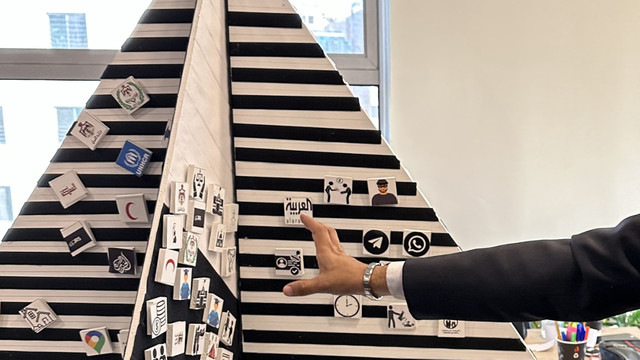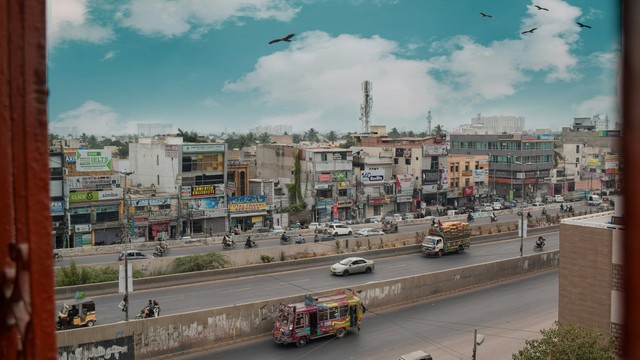Barricading Karachi: how private security contributes to dividing the city
Violence in Karachi will not be reduced until more effective and equitable solutions to policing and urban planning are found. Guest blogger Donald Brown examines the ways physical barriers affect space and people.


Physical barriers have been installed around Karachi to protect the city from violent conflict, but their impacts have been publically disruptive and socially divisive (Photo: Copyright Noman Ahmed and colleagues)
As the world urbanises, many cities are building safer and more cohesive spaces, while others are becoming increasingly dangerous and divided. Of particular concern are the growing numbers of cities in the global South embroiled in violent conflict.
Few cities are more insecure than Karachi – between 2008 and 2012, more than 7,000 people were killed by various forms of violence.
Many observers identify state failures to provide security, growth and welfare as major pathways to such predicaments. Certainly, security and urban planning failures are to blame for much of Karachi's rising poverty, unemployment, inequality and ethno-political tensions.
But, as a new IIED working paper explores, external factors are also to blame for Karachi's fragility. Violence from regional conflict and global conflict has often spilled over into Karachi, most recently via the Afghan war. As a major port city, Karachi has become an asylum for refugees (many being victims and/or perpetrators of violence), a hub for the Afghan heroin trade, and an entry point for arms destined for Afghanistan.
Over time, these factors have combined with governance failures to create the conditions for different forms of violence – ethno-political, sectarian, militant and criminal – to spread throughout the city.
Violence is affecting spaces and people differently
As violence has spread, it has manifested itself in spaces such as:
- Peri-urban areas where the major centres of poverty and violence are concentrated, but where there is a lack of policing
- Low-income neighbourhoods and informal settlements (often peri-urban) where armed groups have concentrated, and where tensions between ethnic groups have intensified
- Apartment buildings where political parties have evicted rival ethnic groups, sometimes inciting armed battles
- Land where private developers and mafias have used forced evictions or in peri-urban locations, acquired land from farmers to capitalise on real estate
- Businesses and marketplaces where mafias have used arson and bomb blasts to free-up valuable inner-city land for re-development
- Streets and public spaces where intended victims and innocent bystanders are vulnerable to target killings and terrorist attacks
- Polling stations where rival political parties have used violence and intimidation to control voters, and
- Educational institutions, including university campuses, where armed student groups have clashed over conflicting ethno-political agendas.
Some spaces are affected at certain times (e.g. polling stations affected by political violence during elections), while others are affected on a daily basis (eg low-income neighbourhoods affected by criminal violence) or sporadically (eg public spaces affected by terrorism).
Different people in these spaces have also been affected differently depending on their social identities and statuses (e.g. income, ethnicity, religion, gender, age, political affiliation, and so on). Of particular concern is the different ways in which women and men are affected by different forms of violence in different spaces.
Physical barriers reinforce existing divisions and ineffective governance
As insecurities have risen, different ethnic and income groups have sought to protect themselves from one another in the absence of effective policing. The use of physical barriers is worsening the situation:
- Forced cul-de sacs where gates and levers create dead ends
- Disrupted footpaths where walls and blocks encroach sidewalks
- Restricted thoroughfares where cargo containers and blocks temporarily close major streets
- Privately controlled public spaces where various barriers occupy the public realm – sometimes for commercial gain;
- Diminishing green strips so now walls and blocks encroach landscaped public spaces,
- Gated neighbourhoods where walls and gates form protective compounds, and
- Secluded peri-urban spaces where armed groups use temporary barriers (e.g. felled electricity polls) to reduce access, but also symbolic mechanisms (e,g, wall chalking) to delineate territorial control.
In most of these cases, barriers have had inequitable effects by, for example, preventing informal vendors from conducting business in higher-income neighbourhoods, forcing women to take detours that expose them to sexual and gender-based violence, and worsening divisions between the rich and poor.
Barriers also reflect how security has become a private rather than public concern. While the privatisation of security may make sense in a divided city, it obscures the state's role in perpetuating insecurity and discourages citizens from engaging with the state to find alternative solutions.
Towards more effective and equitable solutions
Violence will not be reduced until more effective and equitable solutions to policing and urban planning are supported.
Current efforts by the provincial government to remove barriers from public spaces fail to offer alternative solutions. They also overlook the important roles that municipal authorities play in policing and urban planning, and the need to build capacity in these areas. Rather than simply removing barriers, other options should be explored:
- Plan and manage barriers more effectively and equitably – just because the agencies responsible for planning and building control lack capacity and political will does not mean their responsibilities should be overlooked. Doing so would be ultimately counterproductive, especially if opportunities exist to plan and manage barriers more effectively and equitably. So long as alternative security solutions remain lacking, such opportunities should be pursued
- Work with the poorest and most insecure communities – where social tensions and ethnic divisions are high, alternative security solutions are required. Citizen-Police Liaison Committees show how solutions can be co-produced between the police and the poorest and most insecure communities. The critical roles these committees play in providing inputs into community policing and access to justice for the poorest groups deserve further support.
There is great hope that the reinstatement of local elections will provide new opportunities for these solutions to be pursued. But these elections have been further postponed for political reasons.
Even if local elections were held, it remains unclear whether stronger and more accountable municipal authorities would be capable of overcoming widespread corruption and politicisation.
What is clear is the need to build local capacity and confront the ethnic politics that continue to govern Karachi and much of its violence.
A forthcoming workshop will be hosted by IIED's partners at the NED University of Engineering and Technology in Karachi to discuss how these opportunities and challenges can be addressed in practice.
Donald Brown (d.brown.11@ucl.ac.uk) is a consultant in IIED's Human Settlements Group and PhD candidate at the Bartlett Development Planning Unit, University College London.



